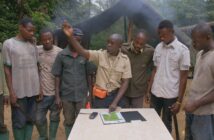YOU can help identify which of the sanctuaries, zoos, and wildlife facilities near you are humane and which should be avoided for their inappropriate captive care and/or for exploiting animals. The Netflix documentary ‘Tiger King’, captured the attention of millions of viewers by highlighting an example of cruel and dangerous animal entertainment park in Wynnewood, Oklahoma. Unfortunately, the show did not spend enough time talking about the issues with the facilities and how it demonstrates dangerous captive care.
The Jane Goodall Institute has worked very hard to establish best-in-class captive welfare at our Tchimpounga Chimpanzee Rehabilitation Center in the Republic of the Congo, largely thanks to Dr. Rebeca Atencia and the Chimpanzee Welfare Index. This ensures that the physical, emotional, and socialization needs of every chimpanzee and chimpanzee groups are accounted for. Our hope is that every facility caring for captive animals takes the time to establish best possible care for their animals.
By taking the time to go through this checklist for each facility, you’ll get a better idea of the quality of the captive animal care near you! Make sure to always do this before visiting, sharing about or engaging with captive animal facilities, in the U.S. or abroad.
- Is the facility accredited by the ASA (American Sanctuary Association) or AZA (Association of Zoos & Aquariums)?
- IF YES, they are likely a good facility.
- IF YES, they are likely a good facility.
- Do your research on the social media accounts, website of the facility, and review photos on sites like Yelp and TripAdvisor. What kind of imagery/reviews do you see?
- Are there photos of people posing with and touching the captive animals? IF YES, they are likely a NOT so good facility, as this is a sign of poor captive care and exploitation.
- Are there photos of people posing with and touching the captive animals? IF YES, they are likely a NOT so good facility, as this is a sign of poor captive care and exploitation.
- Look at their website or reviews of their facility (start with the ‘About’ page/section): Do they limit the hours in the day in which visitors may enter the facility, thereby providing down time for the animals?
- If YES, this is a sign of a good facility.
- If YES, this is a sign of a good facility.
- Look at their website and/or reviews of their facility (maybe specifically the ‘About’ page/section and/or staff page); Do they have a vet on staff?
- If YES, this is a sign of a good facility.
- If YES, this is a sign of a good facility.
- Look at their website or reviews of their facility: Is there enough space in the enclosures for the animals and are the enclosures/animals kept clean (clean food/water)?
- If YES, this is a sign of a good facility.
- If YES, this is a sign of a good facility.
- Airbnb recently updated their ‘Animal Experiences’ areas to be shaped by an important set of captive care guidelines. Learn more and use their platform to search for appropriate experiences!
- Explore Airbnb ‘Animal Experiences’
Learn more about and support JGI’s captive care and rescue of chimpanzees by becoming (or gifting) a Chimpanzee Guardian here.

The Jane Goodall Institute is a global community conservation organization that advances the vision and work of Dr. Jane Goodall. By protecting chimpanzees and inspiring people to conserve the natural world we all share, we improve the lives of people, animals and the environment. Everything is connected—everyone can make a difference.









